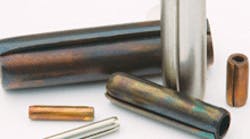Authored by: Christie Jones Edited by Kenneth J. Korane Key points: Pins can be an economical and durable alternative to other mechanical fasteners. Slotted and coiled spring pins offer flexibility and don’t require exacting hole tolerances. Resources: |
Fasteners are usually the smallest, least-expensive components within a machine, but OEMs depend on them to hold entire assemblies together — often for years or decades. And assemblies can be held together in many ways: bolts, rivets, screws, and pins, to name a few.
Assembly techniques generally fall into two broad categories: Methods that take two components or two operational steps to hold parts place; and methods where the components are self-retaining. The challenge for the design engineer is to choose a method that provides the highest quality joint with integrity over time at the lowest manufacturing cost.
For many applications, a self-retaining pin is the winning solution. The difficulty is selecting a pin with the appropriate strength and flexibility for the application. Technically, when a load is applied, something has to give: the pin, the hole, or an element of the assembly. A pin that is too rigid causes the hole in which it is retained to elongate and leads to eventual assembly failure. A pin that is too flexible fatigues under dynamic loading.
Solid pins
Solid pins come in many different forms, including dowel, knurled, and grooved pins. In general, solid pins are strong and relatively inflexible. They do not absorb shock and dynamic loads but, rather, transmit these to the mating components. Solid pins are often effective, but engineers need to closely examine the dynamic forces in many applications.
For example, a common perception is that solid pins are the best option for heavy-duty applications. On the contrary, due to the pin’s inflexibility, solid pins often damage the holes in dynamic-loading applications, which leads to premature failure. Using a softer solid-pin material reduces host damage, but commensurately reduces the pin’s strength. Alternatively, a heat-treated spring pin is often stronger than a solid pin and its inherent flexibility maximizes assembly life in dynamic, heavy-duty applications.
Spring pins
Two distinct types of spring pins are slotted and coiled versions. Both share characteristics such as flexibility and the ability to accommodate wider hole tolerances, compared with solid pins.
Slotted pins’ flexibility reduces manufacturing costs. But several disadvantages limit their applicability in new designs — particularly in applications with a soft host material, such as aluminum or plastic, which are subject to dynamic loading.
Slotted pins are significantly less flexible than the coiled pin and they only flex 180° from the gap. This combination can cause premature assembly failure.
Additionally, slotted pins are difficult to automatically feed and install. The most appropriate applications for slotted pins are noncritical assemblies, manufactured out of mild to hardened steel, that are manually assembled.
Coiled pins address the drawbacks of the slotted pins and let design engineers tailor pin strength and flexibility to match the application. Light-duty pins are generally recommended for soft or brittle materials. Medium (or standard) duty pins are recommended for mild steel and nonferrous assemblies. Heavy-duty pins should be used in hardened components.
Coiled pins are the most capable of absorbing shock and vibration after insertion, often prolonging the useful life of an assembly. And they are conducive for automatic feeding and installation in high-volume production.
They can be used as hinge pins, alignment pins, and stop pins, and to fasten components together (such as to pin a gear and shaft). Coiled pins are not usually recommended as cam followers, or where the pin has a limited length of engagement. These applications are usually best served by a solid pin with retention features.
As important as fasteners are, design engineers usually receive no formal training on the mechanics of fastening and joining. (Not something you want to think about next time you are on an airplane.) And fasteners are often overlooked until the end of the design. That can limit an engineer’s choices and compromise performance, increase costs, or require expensive redesign that delays product introduction. That’s why considering the many different ways to fasten assemblies, engineers should take advantage of the application-engineering services that manufacturers of engineered fasteners provide. This will ensure that the assembly is equipped with the most cost-effective solution that will provide exceptional performance and preserve the integrity of the application throughout the life of the product.
About the Author
Kenneth Korane
Ken Korane holds a B.S. Mechanical Engineering from The Ohio State University. In addition to serving as an editor at Machine Design until August 2015, his prior work experience includes product engineer at Parker Hannifin Corp. and mechanical design engineer at Euclid Inc.
